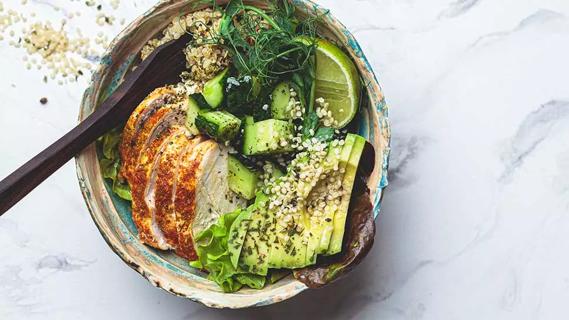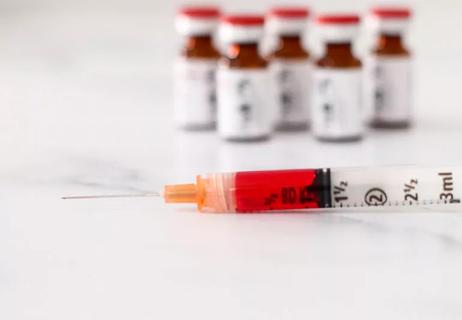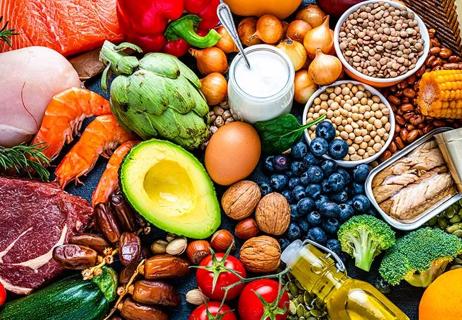B vitamins do a lot for your body, like activate enzymes that give you energy, create blood cells and prevent DNA damage

When you think about vitamins that are essential to your health, you probably think about a lot of different letters. There’s vitamin C, vitamin D, vitamin E, vitamin K and so on and so forth. It’s like an alphabet soup of nutrients.
Advertisement
Cleveland Clinic is a non-profit academic medical center. Advertising on our site helps support our mission. We do not endorse non-Cleveland Clinic products or services. Policy
And then, you get to the B vitamins. And your soup gets a little heartier.
Because there are eight different B vitamins. And they’re all important for your body to go about its day-to-day business effectively and efficiently.
“The main thing that most B vitamins do is help turn our food into energy that your body can use. It helps initiate the processes that turn carbohydrates, fats and proteins into a usable form of energy,” explains registered dietitian Natalie Romito, RDN, LD.
“If you’re deficient in any of the B vitamins, your body will be much less efficient at getting the energy it needs from the foods you’re eating.”
Each B vitamin comes from different foods. They each do slightly different things for your body. You need different amounts of each. Some can have serious health consequences if you get too much of them. Others will do damage if you don’t have enough.
Oh, and in addition to their “B” name, they each have an alternative moniker as well.
Confusing? Perhaps. Important for your well-being? Absolutely.
So, let’s take a look at each of the B vitamins: What they do, how much you need and how to get them.
If there’s one thing all the B vitamins have in common, it’s this: B vitamins are water-soluble vitamins that act as coenzymes.
Advertisement
What does that mean?
Water soluble means they aren’t stored by your body, so you need to eat them daily for the best effects. (One exception to this is vitamin B12. Excess B12 is stored in your liver.)
Coenzyme means they work to power enzymes. Enzymes are proteins that help speed up chemical reactions in your body. But they can’t work on their own. They need coenzymes, like B vitamins and others, to act as a switch that turns them on.
“Each type of vitamin B works on different enzymes. They make sure the enzymes get the power they need to metabolize food, build and repair DNA, grow healthy blood cells and more,” Romito explains. “So, B vitamins essentially ensure those enzymes are able to do their work.”
There are eight B vitamins:
Fun fact for those of you doing the math: There are no vitamins B4, B8, B10 or B11 — at least not anymore. Over time, those substances were found to not be vitamins at all.
Vitamins, by definition, are compounds that are essential for life and aren’t created by your body — you have to get them from foods or supplements.
And just like research has shown that Pluto is no longer considered a planet, B4, B8, B10 and B11 have been proven not to fit the criteria for vitamin status.
That leaves eight B vitamins that are essential for your health. Romito tells us about each of them.
What it does
Thiamin helps your body get energy from the food you eat by turning it into adenosine triphosphate (ATP), which is the energy your cells use. It’s also important for adequate nerve cell function.
“If you go think back to high school biology, you might remember that your cells’ mitochondria are the ‘powerhouses’ that produce energy,” Romito illustrates. “ATP is the energy the mitochondria in your cells use to power your cells. Thiamin helps to create that energy.”
How much you need
Recommended dietary allowances (RDAs) for thiamin are:
Thiamin doesn’t have an upper limit for toxicity. That means you don’t have to worry about getting too much of it.
Thiamin deficiency, on the other hand, can cause health concerns like swelling of the lower extremities, loss of muscle coordination, weight loss, lowered immunity and confusion.
Food sources
Some of the top sources of thiamin in your diet include:
| Food | Serving size | Thiamin content |
|---|---|---|
| Fortified breakfast cereal | 1 serving | 1.2 mg |
| Enriched egg noodles | 1 cup | 0.5 mg |
| Pork chops | 3 ounces | 0.4 mg |
| Cooked trout | 3 ounces | 0.4 mg |
| Black beans | 1/2 cup | 0.4 mg |
| Enriched English muffin | 1 muffin | 0.3 mg |
| Cooked blue mussels | 3 ounces | 0.3 mg |
| Food | ||
| Fortified breakfast cereal | ||
| Serving size | ||
| 1 serving | ||
| Thiamin content | ||
| 1.2 mg | ||
| Enriched egg noodles | ||
| Serving size | ||
| 1 cup | ||
| Thiamin content | ||
| 0.5 mg | ||
| Pork chops | ||
| Serving size | ||
| 3 ounces | ||
| Thiamin content | ||
| 0.4 mg | ||
| Cooked trout | ||
| Serving size | ||
| 3 ounces | ||
| Thiamin content | ||
| 0.4 mg | ||
| Black beans | ||
| Serving size | ||
| 1/2 cup | ||
| Thiamin content | ||
| 0.4 mg | ||
| Enriched English muffin | ||
| Serving size | ||
| 1 muffin | ||
| Thiamin content | ||
| 0.3 mg | ||
| Cooked blue mussels | ||
| Serving size | ||
| 3 ounces | ||
| Thiamin content | ||
| 0.3 mg |
What it does
Riboflavin is a component of two coenzymes that are needed for energy production, cellular function and metabolism. It also helps to make sure the other B vitamins are doing their jobs.
Advertisement
How much you need
RDAs for riboflavin are:
Riboflavin doesn’t have an upper limit for toxicity. Riboflavin deficiency is rare in the United States.
Food sources
Riboflavin is commonly found in many animal products, like meat and dairy. People who don’t consume animal products or who eat them sparingly may be at a higher risk for deficiency, but it’s extremely rare in the U.S. That’s at least in part because some foods that don’t naturally contain riboflavin are commonly fortified with it.
Top sources of riboflavin include:
| Food | Serving size | Riboflavin content |
|---|---|---|
| Fortified breakfast cereal | 1 serving | 1.3 mg |
| Plain yogurt | 1 cup | 0.6 mg |
| 2% milk | 1 cup | 0.5 mg |
| Beef tenderloin | 3 ounces | 0.4 mg |
| Clams | 3 ounces | 0.4 mg |
| Dry-roasted almonds | 3 ounces | 0.3 mg |
| Swiss cheese | 3 ounces | 0.3 mg |
| Food | ||
| Fortified breakfast cereal | ||
| Serving size | ||
| 1 serving | ||
| Riboflavin content | ||
| 1.3 mg | ||
| Plain yogurt | ||
| Serving size | ||
| 1 cup | ||
| Riboflavin content | ||
| 0.6 mg | ||
| 2% milk | ||
| Serving size | ||
| 1 cup | ||
| Riboflavin content | ||
| 0.5 mg | ||
| Beef tenderloin | ||
| Serving size | ||
| 3 ounces | ||
| Riboflavin content | ||
| 0.4 mg | ||
| Clams | ||
| Serving size | ||
| 3 ounces | ||
| Riboflavin content | ||
| 0.4 mg | ||
| Dry-roasted almonds | ||
| Serving size | ||
| 3 ounces | ||
| Riboflavin content | ||
| 0.3 mg | ||
| Swiss cheese | ||
| Serving size | ||
| 3 ounces | ||
| Riboflavin content | ||
| 0.3 mg |
What it does
Niacin is converted into a coenzyme that’s used throughout the body for several different processes. It helps transfer the energy found in food into ATP. It also helps with the creation and repair of DNA. Niacin is also an ingredient in some skin care products, where it’s touted for its anti-aging effects and for helping to clear up eczema and acne.
How much you need
RDAs for niacin are:
Advertisement
Niacin can be dangerous when taken in very large quantities. It can cause flushing, redness and itchiness throughout the skin. So, it’s advised to avoid supplements that contain high doses of niacin.
And while deficiency isn’t as common these days, it used to be a big problem in some cultures. There’s evidence that some indigenous cultures in North and Central America would process corn to make it better fit for consumption.
“Pellagra is a nutritional disease that was common in the first half of the 20th century among people with corn-based diets who consumed corn that wasn’t processed to allow niacin to be absorbed,” Romito shares. “Some indigenous cultures processed corn as early as 2000 BC to make niacin absorbable. Today, food manufacturers continue to fortify food so that pellagra isn’t a concern for most people.”
People who are undernourished may still be at an increased risk for niacin deficiency. That includes people who are living with:
Food sources
Top sources of niacin include:
| Food | Serving size | Niacin content |
|---|---|---|
| Chicken breast | 3 ounces | 10.3 mg |
| Marinara sauce | 1 cup | 10.3 mg |
| Turkey breast | 3 ounces | 10 mg |
| Cooked sockeye salmon | 3 ounces | 8.6 mg |
| Light canned tuna | 3 ounces | 8.6 mg |
| Pork tenderloin | 3 ounces | 6.3 mg |
| Ground beef | 3 ounces | 5.8 mg |
| Cooked brown rice | 1 cup | 5.2 mg |
| Dry-roasted peanuts | 1 ounce | 4.2 mg |
| Fortified breakfast cereal | 1 serving | 4 mg |
| Food | ||
| Chicken breast | ||
| Serving size | ||
| 3 ounces | ||
| Niacin content | ||
| 10.3 mg | ||
| Marinara sauce | ||
| Serving size | ||
| 1 cup | ||
| Niacin content | ||
| 10.3 mg | ||
| Turkey breast | ||
| Serving size | ||
| 3 ounces | ||
| Niacin content | ||
| 10 mg | ||
| Cooked sockeye salmon | ||
| Serving size | ||
| 3 ounces | ||
| Niacin content | ||
| 8.6 mg | ||
| Light canned tuna | ||
| Serving size | ||
| 3 ounces | ||
| Niacin content | ||
| 8.6 mg | ||
| Pork tenderloin | ||
| Serving size | ||
| 3 ounces | ||
| Niacin content | ||
| 6.3 mg | ||
| Ground beef | ||
| Serving size | ||
| 3 ounces | ||
| Niacin content | ||
| 5.8 mg | ||
| Cooked brown rice | ||
| Serving size | ||
| 1 cup | ||
| Niacin content | ||
| 5.2 mg | ||
| Dry-roasted peanuts | ||
| Serving size | ||
| 1 ounce | ||
| Niacin content | ||
| 4.2 mg | ||
| Fortified breakfast cereal | ||
| Serving size | ||
| 1 serving | ||
| Niacin content | ||
| 4 mg |
What it does
Pantothenic acid is used to make coenzyme A, which helps enzymes to build and break down fatty acids. It also is a popular and helpful ingredient in some skin care and hair care products.
Advertisement
How much you need
Adequate intakes for pantothenic acid are:
There’s no upper limit for vitamin B5. And as long as you’re eating adequate calories, it’s very uncommon for people to be deficient in pantothenic acid.
Food sources
Pantothenic acid is common in many foods we eat every day.
“Pantothenic acid comes from the Greek word ‘pantos,’ which means ‘everywhere’ because it’s in so many foods and food groups,” Romito shares.
Some of the top sources of vitamin B5 include:
| Food | Serving size | Pantothenic acid content |
|---|---|---|
| Fortified breakfast cereal | 1 serving | 8.3 mg |
| Shitake mushrooms | 1/2 cup | 5 mg |
| Sunflower seeds | 1/4 cup | 2.4 mg |
| Chicken breast | 3 ounces | 1.3 mg |
| Fresh cooked bluefin tuna | 3 ounces | 1.2 mg |
| 2% milk | 1 cup | 0.9 mg |
| Food | ||
| Fortified breakfast cereal | ||
| Serving size | ||
| 1 serving | ||
| Pantothenic acid content | ||
| 8.3 mg | ||
| Shitake mushrooms | ||
| Serving size | ||
| 1/2 cup | ||
| Pantothenic acid content | ||
| 5 mg | ||
| Sunflower seeds | ||
| Serving size | ||
| 1/4 cup | ||
| Pantothenic acid content | ||
| 2.4 mg | ||
| Chicken breast | ||
| Serving size | ||
| 3 ounces | ||
| Pantothenic acid content | ||
| 1.3 mg | ||
| Fresh cooked bluefin tuna | ||
| Serving size | ||
| 3 ounces | ||
| Pantothenic acid content | ||
| 1.2 mg | ||
| 2% milk | ||
| Serving size | ||
| 1 cup | ||
| Pantothenic acid content | ||
| 0.9 mg |
What it does
Vitamin B6 is probably one of the more famous B vitamins.
One of its jobs is to help maintain proper levels of the amino acid homocysteine. Your body naturally produces homocysteine. But too much of it can lead to things like blood clots, hardened arteries and heart attack.
Vitamin B6 targets homocysteine and breaks it down into other substances that your body needs. That keeps homocysteine from building up and causing damage.
Vitamin B6 also helps support your metabolism, immune system, brain health and many other functions. In all, it’s involved in more than 100 enzyme reactions in your body.
How much you need
RDAs for vitamin B6 are:
Excessive amounts of vitamin B6 from supplements can cause severe effects. So, the National Institutes of Health advises that the upper limit of vitamin B6 is 100 mg per day.
“Vitamin B6 can cause neuropathy (nerve damage) if you’re getting a very high dose for a long period of time,” Romito cautions. “That can lead to loss of control of body movements. So, you want to be very careful about taking supplements with vitamin B6. You can get too much of a good thing.”
Food sources
Some of the top sources of vitamin B6 include:
| Food | Serving size | Vitamin B6 content |
|---|---|---|
| Canned chickpeas | 1 cup | 1.1 mg |
| Fresh cooked yellowfin tuna | 3 ounces | 0.9 mg |
| Cooked sockeye salmon | 3 ounces | 0.6 mg |
| Roasted chicken breast | 3 ounces | 0.5 mg |
| Fortified breakfast cereal | 1 serving | 0.4 mg |
| Boiled potatoes | 1 cup | 0.4 mg |
| Roasted turkey | 3 ounces | 0.4 mg |
| Banana | 1 medium banana | 0.4 mg |
| Marinara sauce | 1 cup | 0.4 mg |
| Food | ||
| Canned chickpeas | ||
| Serving size | ||
| 1 cup | ||
| Vitamin B6 content | ||
| 1.1 mg | ||
| Fresh cooked yellowfin tuna | ||
| Serving size | ||
| 3 ounces | ||
| Vitamin B6 content | ||
| 0.9 mg | ||
| Cooked sockeye salmon | ||
| Serving size | ||
| 3 ounces | ||
| Vitamin B6 content | ||
| 0.6 mg | ||
| Roasted chicken breast | ||
| Serving size | ||
| 3 ounces | ||
| Vitamin B6 content | ||
| 0.5 mg | ||
| Fortified breakfast cereal | ||
| Serving size | ||
| 1 serving | ||
| Vitamin B6 content | ||
| 0.4 mg | ||
| Boiled potatoes | ||
| Serving size | ||
| 1 cup | ||
| Vitamin B6 content | ||
| 0.4 mg | ||
| Roasted turkey | ||
| Serving size | ||
| 3 ounces | ||
| Vitamin B6 content | ||
| 0.4 mg | ||
| Banana | ||
| Serving size | ||
| 1 medium banana | ||
| Vitamin B6 content | ||
| 0.4 mg | ||
| Marinara sauce | ||
| Serving size | ||
| 1 cup | ||
| Vitamin B6 content | ||
| 0.4 mg |
Remember, vitamin B6 is only dangerous in amounts over 100 mg per day. Given the vitamin B6 content in foods, you can rest assured you won’t go over that threshold in your diet. It’s when you take supplements with high levels of vitamin B6 that you can go over that limit. So, stick to food sources for your vitamin B6 intake.
What it does
Biotin is perhaps most known as a nutrient for healthy hair, nails and skin. But whether biotin supplements and biotin-added beauty products actually give you a more luxurious mane or long, strong nails is still up for debate.
“Using biotin has been shown to improve brittle nail syndrome, but it’s believed that biotin deficiency may not actually be the cause,” Romito says. “It’s more likely another underlying issue, like iron deficiency, medications or hypothyroidism, cause brittle nails, but biotin can help improve the condition.”
What we do know is that eating foods with biotin assists the enzymes that break down fats, carbs and proteins in your food. It also helps ensure your cells work together effectively and that they carry out their assigned tasks based on the instructions set out by your genes.
How much you need
RDAs for biotin are:
There’s no upper limit to how much biotin is considered safe.
Food sources
Some of the top sources of biotin include:
| Food | Serving size | Biotin content |
|---|---|---|
| Eggs | 1 egg | 10 mcg |
| Pink canned salmon | 3 ounces | 5 mcg |
| Pork chops | 3 ounces | 3.8 mcg |
| Hamburger patties | 3 ounces | 3.8 mcg |
| Roasted sunflower seeds | 1/4 cup | 2.6 mcg |
| Sweet potato | 1/2 cup | 2.4 mcg |
| Roasted almonds | 1/4 cup | 1.5 mcg |
| Food | ||
| Eggs | ||
| Serving size | ||
| 1 egg | ||
| Biotin content | ||
| 10 mcg | ||
| Pink canned salmon | ||
| Serving size | ||
| 3 ounces | ||
| Biotin content | ||
| 5 mcg | ||
| Pork chops | ||
| Serving size | ||
| 3 ounces | ||
| Biotin content | ||
| 3.8 mcg | ||
| Hamburger patties | ||
| Serving size | ||
| 3 ounces | ||
| Biotin content | ||
| 3.8 mcg | ||
| Roasted sunflower seeds | ||
| Serving size | ||
| 1/4 cup | ||
| Biotin content | ||
| 2.6 mcg | ||
| Sweet potato | ||
| Serving size | ||
| 1/2 cup | ||
| Biotin content | ||
| 2.4 mcg | ||
| Roasted almonds | ||
| Serving size | ||
| 1/4 cup | ||
| Biotin content | ||
| 1.5 mcg |
What it does
Vitamin B9, commonly called folate (in food form) and folic acid (in supplement form), is the B vitamin most associated with pregnancy and prenatal vitamins. That’s because folate is critical for proper formation of the neural tube in early pregnancy. That’s the structure that forms the early brain and spine in a developing fetus.
“Folate is very important for people who could become pregnant because often, the neural tube develops before you even know you’re pregnant,” Romito explains. “If you’re low in folate in those early days of pregnancy, it can raise a risk of the fetus having birth defects like spina bifida, a condition where the neural tube doesn't fully close.”
And even if you’re not pregnant, folate is an important component of your healthy eating plan. It helps your body to:
How much you need
RDAs for folate are:
Romito advises that taking folate supplements for long periods can hide the effects of a vitamin B12 deficiency, which can be dangerous. So, supplements aren’t recommended except for people who are pregnant or may become pregnant or who are otherwise advised to by their healthcare provider.
Food sources
Some of the top sources of folate include:
| Food | Serving size | Folate content |
|---|---|---|
| Boiled spinach | 1/2 cup | 131 mcg |
| Black-eyed peas | 1/2 cup | 105 mcg |
| Fortified breakfast cereal | 1 serving | 100 mcg |
| Fortified white rice | 1/2 cup | 90 mcg |
| Boiled asparagus | 4 spears | 89 mcg |
| Boiled Brussels sprouts | 1/2 cup | 78 mcg |
| Enriched, fortified spaghetti | 1/2 cup | 74 mcg |
| Romaine lettuce | 1 cup | 64 mcg |
| Avocado | 1/2 cup | 59 mcg |
| Raw spinach | 1 cup | 58 mcg |
| Cooked broccoli | 1/2 cup | 52 mcg |
| Boiled mustard greens | 1/2 cup | 52 mcg |
| Food | ||
| Boiled spinach | ||
| Serving size | ||
| 1/2 cup | ||
| Folate content | ||
| 131 mcg | ||
| Black-eyed peas | ||
| Serving size | ||
| 1/2 cup | ||
| Folate content | ||
| 105 mcg | ||
| Fortified breakfast cereal | ||
| Serving size | ||
| 1 serving | ||
| Folate content | ||
| 100 mcg | ||
| Fortified white rice | ||
| Serving size | ||
| 1/2 cup | ||
| Folate content | ||
| 90 mcg | ||
| Boiled asparagus | ||
| Serving size | ||
| 4 spears | ||
| Folate content | ||
| 89 mcg | ||
| Boiled Brussels sprouts | ||
| Serving size | ||
| 1/2 cup | ||
| Folate content | ||
| 78 mcg | ||
| Enriched, fortified spaghetti | ||
| Serving size | ||
| 1/2 cup | ||
| Folate content | ||
| 74 mcg | ||
| Romaine lettuce | ||
| Serving size | ||
| 1 cup | ||
| Folate content | ||
| 64 mcg | ||
| Avocado | ||
| Serving size | ||
| 1/2 cup | ||
| Folate content | ||
| 59 mcg | ||
| Raw spinach | ||
| Serving size | ||
| 1 cup | ||
| Folate content | ||
| 58 mcg | ||
| Cooked broccoli | ||
| Serving size | ||
| 1/2 cup | ||
| Folate content | ||
| 52 mcg | ||
| Boiled mustard greens | ||
| Serving size | ||
| 1/2 cup | ||
| Folate content | ||
| 52 mcg |
What it does
Vitamin B12 is another of the heavy hitters of the B vitamin empire. It helps form red blood cells and DNA. It also is important for organ and brain function.
How much you need
RDAs for vitamin B12 are:
A vitamin B12 deficiency can cause irreversible brain damage. But it can be harder for some people to get adequate amounts of vitamin B12 in their diets. Risks for deficiency can include:
Food sources
Some of the top sources of vitamin B12 include:
| Food | Serving size | Vitamin B12 content |
|---|---|---|
| Cooked clams (without shells) | 3 ounces | 17 mcg |
| Fortified nutritional yeast | 1/4 cup | 8.3 to 24 mcg (depending on brand) |
| Cooked Atlantic salmon | 3 ounces | 2.6 mcg |
| Canned light tuna | 3 ounces | 2.5 mcg |
| Ground beef | 3 ounces | 2.4 mcg |
| 2% milk | 1 cup | 1.3 mcg |
| Plain yogurt | 6 ounces | 1 mcg |
| Fortified breakfast cereal | 1 serving | 0.6 mcg |
| Cheddar cheese | 1.5 ounces | 0.5 mcg |
| Eggs | 1 large egg | 0.5 mcg |
| Food | ||
| Cooked clams (without shells) | ||
| Serving size | ||
| 3 ounces | ||
| Vitamin B12 content | ||
| 17 mcg | ||
| Fortified nutritional yeast | ||
| Serving size | ||
| 1/4 cup | ||
| Vitamin B12 content | ||
| 8.3 to 24 mcg (depending on brand) | ||
| Cooked Atlantic salmon | ||
| Serving size | ||
| 3 ounces | ||
| Vitamin B12 content | ||
| 2.6 mcg | ||
| Canned light tuna | ||
| Serving size | ||
| 3 ounces | ||
| Vitamin B12 content | ||
| 2.5 mcg | ||
| Ground beef | ||
| Serving size | ||
| 3 ounces | ||
| Vitamin B12 content | ||
| 2.4 mcg | ||
| 2% milk | ||
| Serving size | ||
| 1 cup | ||
| Vitamin B12 content | ||
| 1.3 mcg | ||
| Plain yogurt | ||
| Serving size | ||
| 6 ounces | ||
| Vitamin B12 content | ||
| 1 mcg | ||
| Fortified breakfast cereal | ||
| Serving size | ||
| 1 serving | ||
| Vitamin B12 content | ||
| 0.6 mcg | ||
| Cheddar cheese | ||
| Serving size | ||
| 1.5 ounces | ||
| Vitamin B12 content | ||
| 0.5 mcg | ||
| Eggs | ||
| Serving size | ||
| 1 large egg | ||
| Vitamin B12 content | ||
| 0.5 mcg |
Though vitamin B12 is found naturally in animal products, many other foods have been fortified with vitamin B12. People who don’t eat animal products are advised to seek out fortified foods and to talk with a healthcare provider about vitamin B12 supplements if they’re concerned about their intake.
“Vitamin B12 is a lot harder to come by for people who don’t eat animal products,” Romito relays. “People who are vegan or vegetarian are generally advised to take a vitamin B12 supplement rather than relying on fortified foods.”
In most cases, Romito says most people should seek to get their B vitamins from foods rather than from supplements.
“Ideally, you want to have a varied diet that provides all the vitamins you need,” she states. “Eating whole foods gives you so many nutrients your body needs, not just B vitamins, but also things like fiber and antioxidants that you’re not going to get in a supplement.”
Two exceptions to the “food-first” rule:
For others who are at risk of deficiency or who want some assurance that they’re getting the B vitamins their body needs, Romito has some additional advice: “If somebody really wants to take a supplement, I encourage you to look for ones that have 100% of the recommended dietary allowance. Some of those products contain super high doses — 2,000% of the RDA and even higher. More is not always better. And in some cases, it can be harmful.”
Learn more about our editorial process.
Advertisement

Also known as pantothenic acid, vitamin B5 helps your metabolism and is found in a wide range of foods

There are several vitamins and mineral supplements that many people can benefit from — but it’s important to consult with a healthcare provider before you start one

If you have low B12 or a true deficiency, these shots can work wonders

Getting enough thiamine in your diet can protect your heart, brain and nervous system

Vitamin C and B-complex vitamins pass quickly through your body, so eat them often

Iron, biotin and omega-3 fatty acids can help your strands

Type 2 diabetes isn’t inevitable with these dietary changes

Applying a hot or cold compress can help with pain